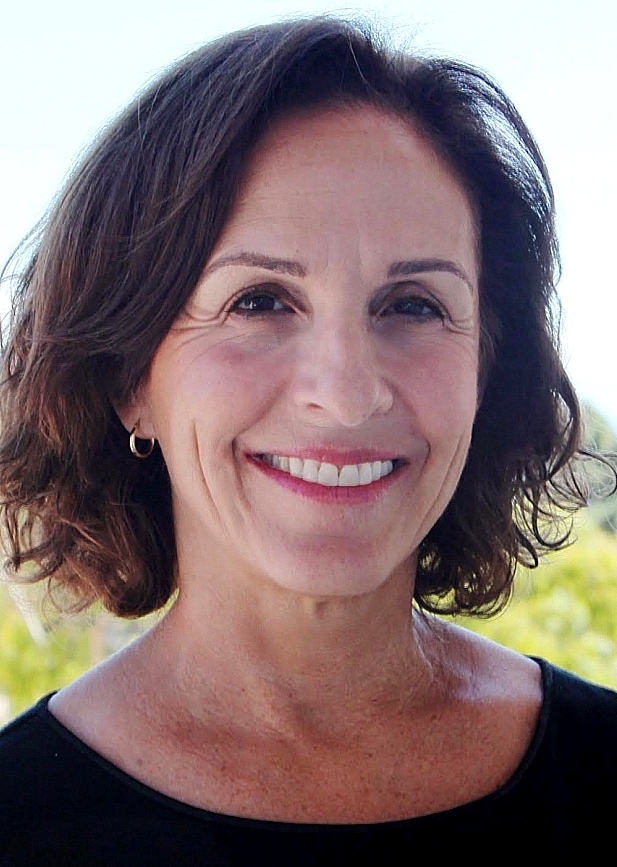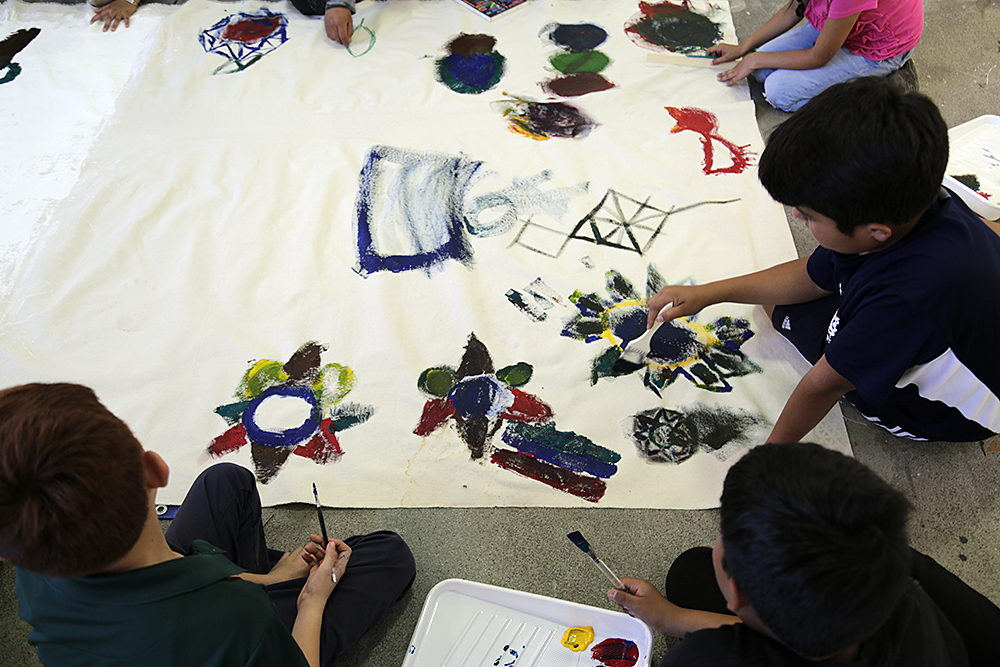Teaching Artists

More than a dozen elementary school students crowd around a large canvas, laughing and talking — but mostly concentrating — as they use paint, pastels and pencils to create large and small abstract designs that will eventually come together to form one cohesive mural.
Suddenly, their teacher instructs them to put down their tools and choose a different section of canvas, adding another layer or shape to what has already been created by someone else. “You don’t have to finish what you started,” the teacher says. “Let someone else take over. That’s part of the fun.”
This lesson in the joy of collaboration is one of many at the heart of UC Santa Barbara’s Artists in Schools program, a partnership between the university’s Interdisciplinary Humanities Center (IHC) and the Franklin Service Center (FSC), which provides after-school enrichment programming and other resources for students of Franklin Elementary School in Santa Barbara.
The program, now in its second year, pairs UCSB graduate and post-graduate scholars from fine arts disciplines with small groups of elementary school students for intensive workshops in visual art and theater. This structure serves a dual purpose: it allows the young students to practice making art, and the older students to practice teaching.
“Everybody is learning in this,” said Susan Derwin, director of the IHC. “The teachers are learning, and the students are learning.”
The IHC currently supports three different art classes and three theater classes at the FSC, and plans to add music to the curriculum in the fall. Students have learned brush painting, written monologues and adapted fables, among other artistic pursuits.
“Our goal is to give young people these expressive, reflective tools, which they can use their whole lives, whether they choose to pursue the arts or not,” said Derwin, also a professor of comparative literature. “That capacity to symbolize both internal and external worlds is extremely empowering and humanistic.”
Sunny Samuel, a post-graduate teaching fellow and lecturer in the Department of Art and in UCSB’s College of Creative Studies, has taught two different courses as part of the Artists in Schools program. He is currently leading a group (the aforementioned mural painters) in an exploration of forms and patterns as viewed through a microscope.
“My work toggles between the differences of looking, seeing and imagining,” he said. “My students and I spent time looking at pinecones, rocks, leaves, branches, their own hands, et cetera, with improvised microscopes. The students were absolutely captivated by the shapes, forms and patterns of these objects and materials on the microscopic scale.”
In order to be effective teachers, the graduate and post-graduate instructors have to distill their own specialized practice into approachable, hands-on activities for kids. Samuel, whose work deals with “artworks about phenomena on the scale of the micro that can generate ideas and questions about culture at the scale of the macro,” showed his students how to notice and appreciate the contrast between common objects and their textures as viewed up close.
Franklin Elementary School serves many underrepresented and minority students — 91 percent are considered “socioeconomically disadvantaged,” and 66 percent are English Language Learners, according to recent data from the California Department of Education. With limited funding for art classes during regular school hours, the Artists in Schools program supplements its existing curriculum.
“By being exposed to different types of arts, our students are learning many lessons, including self-expression, how to communicate and how to begin to plan their futures,” said Alejandra Gutierrez, director of the Franklin Service Center. “I truly believe that many children are artistic and have limited channels to develop their medium. This program is the first step in that direction.”
An introduction to the arts at a young age also encourages continued arts education, said Erin Nerstad, associate director of the IHC. “This program has the effect of diversifying arts enrollment in middle school and high school because the students who don’t come in with any prior arts experience tend not to opt in to arts electives,” Nerstad explained.
What’s more, the Artists in Schools program influences how its young students view higher education overall. During field trips to UCSB, the children are exposed to a university environment — often for the first time — and to the idea that the arts are a possible field of study.
“One of the things that has emerged is that when the students work with our graduate students and see adults who are students making and studying art, they’re introduced to the idea that not only can you make art as a vocation, but you can actually attend university by doing this,” said Derwin. “They’re not only coming here as visitors, they’re coming as students.”
Those students will return to the UCSB campus Friday, May 4, for an official showcase of their art and a banquet celebrating their accomplishments. “This program is a way to introduce the university, whether it’s literally this university or symbolically any university, into their realm of future educational possibilities,” Derwin said.
For his part, Samuel says that interacting with younger students has changed both his approach to teaching and the way he approaches his own work. “Elementary school children, through a variety of pressures, are often very concerned with making sure their drawings and paintings appear realistic, and if they fail to capture this realism, they end up considering themselves a failure at being an artist,” he said.
“Once students are able to let go of their fear of not depicting something realistically, they have a wonderful, free-flowing, inimitable style of making art that often shines as much light on who they are as what they are depicting,” he continued. “My students have taught me, especially when I’m stuck in a rut in my studio, to be brave and go for it.”




